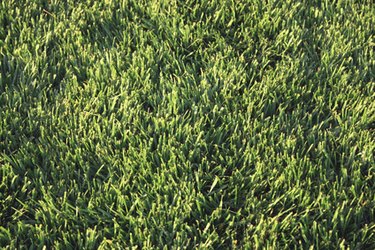
Weed grass identification can be difficult since many of the aggressive grassy weeds look similar, but there are some distinct identifiers for the common weeds. A properly maintained lawn grows thick enough to choke out any lawn weeds. However, a lawn weakened by weather, pests, or disease gives way to the sprouting of unwanted weeds. Before starting any weed-killing program, identify the type of weeds growing in your lawn. Weed grasses in particular prove adept at blending in with the rest of your lawn, making it difficult to get rid of them.
Weed Grass Identification
Video of the Day
Weed grasses closely resemble lawn grasses, making them more difficult to identify than other weed types. True grasses, grassy weeds grow as monocots, meaning they germinate from a seed and produce one leaf. These weeds develop hollow stems with joints and leaf blades that stretch longer than their width. They also grow a multitude of fibrous roots and have unremarkable flowers.
Video of the Day
Preventing Grassy Weeds
The best weed prevention method is to maintain a healthy lawn. Proper lawn maintenance includes fertilizing according to soil test recommendations, watering deeply while letting the ground dry between watering, and mowing at an adequate height, usually no lower than 2 1/2 inches.
Sometimes, though, weeds grow despite the best prevention attempts, and application of chemical herbicides becomes the next step. A preemergent herbicide usually works the best to combat the unwanted presence of weeds. Some weed control products are designed for specific types of weeds, such as crabgrass killer. When using any chemical or herbicide, make certain to read the label and follow directions.
Identification of Bermudagrass
A summer-loving weed, bermudagrass (Cynodon dactylon, USDA zones 7-10) rapidly advances across your lawn as the weather warms. Also a type of turfgrass, it has fine-textured leaves and grows in a creeping pattern, spreading through rhizomes and stolons. While often confused with crabgrass, bermudagrass has narrower leaves that come to a point. If this weed grass sprouts in a lawn with cool season grasses, it can quickly take over.
Crabgrass Weed Identification
An annual weed grass, crabgrass (Digitaria spp.) appears low and flat to the ground with the stems growing outward from a central clump, similar to crab legs. It has thick, coarse, lime green leaves and seed heads that look like spiky fingers coming out from the top of the stem. Some types of crabgrass have dense hairs on the leaves and leaf sheaths, but smooth crabgrass has no hairs on it.
Crabgrass grows best in the unrelenting summer heat that can quickly turn green lawns brown. Crabgrass doesn't grow in shady places, as it requires full sun. The life span of this grass weed begins as a seed that sprouts in May and dies at the first hard frost.
Identification of Dallisgrass
Dallisgrass (Paspalum dilatatum, zones 6-9) grows as a perennial grass weed best identified by its long seed heads. Its foliage has a light green color, and it thrives in wet, hot conditions. Its growth pattern follows a circular clump design as it expands out from the center of the weed. The clump can get so large that the center section starts to die on its own.
Quackgrass and Bentgrass Identification
These two weed grasses also grow as perennials. Bentgrass (Agrostis palustris, zones 3-6) has shallow roots and grows in puffy, fine-textured yet dense patches in your yard. The blades typically have a bluish green color with a narrow, flat, pointed shape. Look for a purple to red color on the lower section of the grass shoots, which are also often hairless.
Quackgrass (Elymus repens, zones 4-8), on the other hand, grows underground through rhizomes that continue to sprout if not completely removed. It usually grows in the lawn in patches, spreading through the coarse root system. You can identify quackgrass by its auricles, which are ear-shaped sections, that clasp the stem. The seed head is a long, narrow spike. Mature quackgrass plants grow straight and tall with the possibility of reaching 3 feet tall if they're not mowed.
- University of Maryland Extension: Lawn Weed ID and Management
- University of New Hampshire Cooperative Extension: How Can I Get Rid of Crabgrass in My Lawn?
- Turfgrass Science at Purdue University: Quackgrass
- University of Minnesota Extension: Creeping Bentgrass
- University of Maryland Extension: Dallisgrass